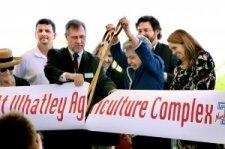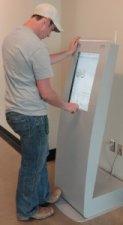The Elizabeth Hoggatt Whatley Agriculture Complex, designed to complement the sustainable agriculture program at NTCC, is intended to serve as a teaching tool for students and the local community as to the benefits of sustainable technologies, as well as to help encourage rural, small-farm based economic development in northeast Texas. The building is LEED® certified platinum, a standard established by the US Green Building Council.
“I can only imagine what people think when they drive by,” says agriculture student Michael Rundle. “Their first reaction is probably ‘What in the world is that?’ It’s the most unbelievable thing you’ve ever seen on a community college campus.”
The complex, in operation since October 2010, houses a new classroom building and Agriculture Pavilion, all intended to drive curriculum for students within the College’s agriculture program. Sustainable components built into the design include a rainwater harvest catchment basin, energy efficient heat pumps, a lighting control system, a photovoltaic solar array and a Skystream 3.7 wind turbine, both intended to provide on-site renewable energy.
An energy management dashboard display in the building lobby allows individuals a chance to see the energy being produced by both the solar array and wind turbine in contrast to the energy being consumed. The energy produced on site is anticipated to be equal the amount purchased, what is termed a net zero building.
LEED® credits included in the building’s design:
-
Optimized energy performance is 42% better than baseline
-
On-site PV panels produce enough electricity to offset purchased electricity
-
Pervious parking lot paving reduces heat island effects and rainwater runoff
-
Rainwater that does run off from parking lot is contained and filtered to substantially reduce the amount of oils and other contaminants passed into local creeks
-
78% of construction waste material was sent to recycling centers
-
37% of the building materials are recycled
-
40% of the building materials were extracted and manufactured within 500 miles of the project site
-
89% of the wood materials were derived from Forest Stewardship Council Certified sources
-
Rainwater from the roof is collected in the pond for use on site
-
Reduced indoor air contaminants through the use of low VOC-emitting materials
- All classrooms and offices receive natural daylight and have views to the outdoor environment
To learn more about the Elizabeth Hoggatt Whatley Agriculture Complex, read this article which appeared in the Summer 2011 issue of Edible Dallas & Fort Worth (please note that this file is very large).


